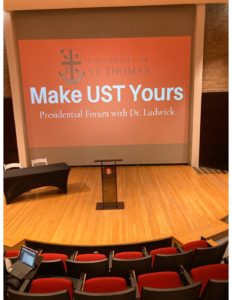Commuters Seek Emergency Housing on Campus During
Tropical Storm Imelda
Twenty-one students stayed on campus overnight on Sept. 19 due to flooding from Tropical Storm Imelda.
According to Director of Residence Life Ana Alicia Lopez, “Nine people stayed over with a friend, six people stayed in an empty bed and six people slept on the floor in either the conference room, which was assigned for boys, or the media room, which was assigned for girls.”
Freshman biology major Alexis Shamburg was one of them. She said she had no choice but to stay overnight on campus.
Shamburg came to class early on Sept. 19 knowing it was going to rain, but she said she assumed that “if it was dangerous, then the school would have told us not to come.”
At 5:50 a.m., UST sent a text to students and faculty that said, “Due to weather, UST delays opening the campus today until 10 a.m. Drive safely.”
By 10 a.m., it was dark outside, and Houston was expecting heavy rain.
At 10:50 a.m., UST sent another text that said, “UST Travel Alert: if [you] are traveling to campus now, please stay at home because of road conditions. If you are on campus, please stay here until storm passes.”
As a student who commutes by METRO bus, Shamburg found herself without transportation: According to the METRO Houston Twitter, all METRO bus and rail services were halted by 9:26 a.m. on Thursday.
Shamburg decided to seek on-campus housing.
“During orientation, I remember being told that the campus offers emergency dorming, so I made my way to the dorm building,” Shamburg said.
At Guinan Hall, Shamburg spoke to two students working at the front desk. They told her they could not offer her a place to stay because “if they gave [her] a dorm, then they would have to give everyone a dorm.”
Lopez said Guinan Hall wasn’t offering emergency housing at that time because UST’s emergency management team, made up of administrative members and faculty, had not yet determined the storm to be dangerous for students.
After, Shamburg went to the UST Police Department, where the staff told her they would have to wait until after 5 p.m. to offer any housing because they were still hoping the rain would recede.
Around 1:13 p.m., without a sign of a decrease in rain, UST sent its last alert with text that read, “UST is closed at 1 p.m. today and classes are canceled. Campus buildings open until storm passes. Use extreme caution when traveling. Thxs.”
According to Vice President for Marketing and University Relations Jeff Olsen, who also works as the director of communications on the emergency management team, UST deploys messages as soon as UST Police Chief H.E. Jenkins makes a safety recommendation on whether the school should be open or delayed.
“On the mornings of things like this, Chief and I get up at 4 a.m., and we talk on the phone, and we review things that early because we want to get a message out as early as possible,” Olsen said.
Olsen said the majority of the forecasts did not believe Imelda would “kind of come back and sit over the top of us.”
“As soon as we saw that the mayor was saying ‘stay where you are,’ and we realized that there was potential that some students might not make it home,” he said. “I called over Dr. Ludwick, and I called the VP of Student Affairs [Patricia McKinley] and asked her to begin setting enough preparations for the dormitories to be open for any students that might be stuck here,”
Olsen said he and Sandra Solis, UST’s director of communications, walked around the University to try to let students such as Shamburg know they had a safe option on campus.
“I was finally given a place to stay after spending a whole day not knowing if I was going to have anywhere to sleep that night,” Shamburg said.
Junior biology and history major Brittany Ramirez was one of many students who complained about the way UST handled communication during Imelda.
On the University’s app, Ramirez advocated for a bigger parking garage, free parking and free meals for students during emergency weather situations at UST.
Shamburg commented under Ramirez’s post suggesting there be emergency housing or cots set up in a classroom for stranded students.
Senior accounting and finance major Abigail Nava, remembers being told at her transfer student orientation there were accommodations available for commuters in case they couldn’t return home safely.
However, Nava said the orientation staff told commuters that emergency accommodations for them would only be available if they knew a student living on-campus.
On normal occasions, the resident requests a pass from their residence assistant for guests wanting to stay on campus overnight; same-sex guest are required. Then the guest must be approved by the Residence Life Office at least 24 hours prior to the night of stay. The general rules, except for same-sex guests, do not apply during times of emergency according to Lopez.
“Emergency overnights are offered on an extremely limited basis and only in the cases of true emergencies,” Lopez said.
A true emergency is defined as any situation where a student’s safety might be at risk, according to Olsen.
Lopez said during such emergencies, students may stay with a current resident or in an empty room. However, that student must alert campus police or the RA On-Call for a room.
If no empty rooms are available, then the student will be offered a “locked community space,” such as a conference or media room, she said.
“If you find yourself in an emergency, whether it’s housing, any type of emergency, the police are your best first point of contact,” Lopez said. “No matter what’s happening, they are going to have the most accurate information.”
Students who need emergency housing should call UST Police at 713-525-3888 or the RA on call at 713-208-0244.







Be First to Comment